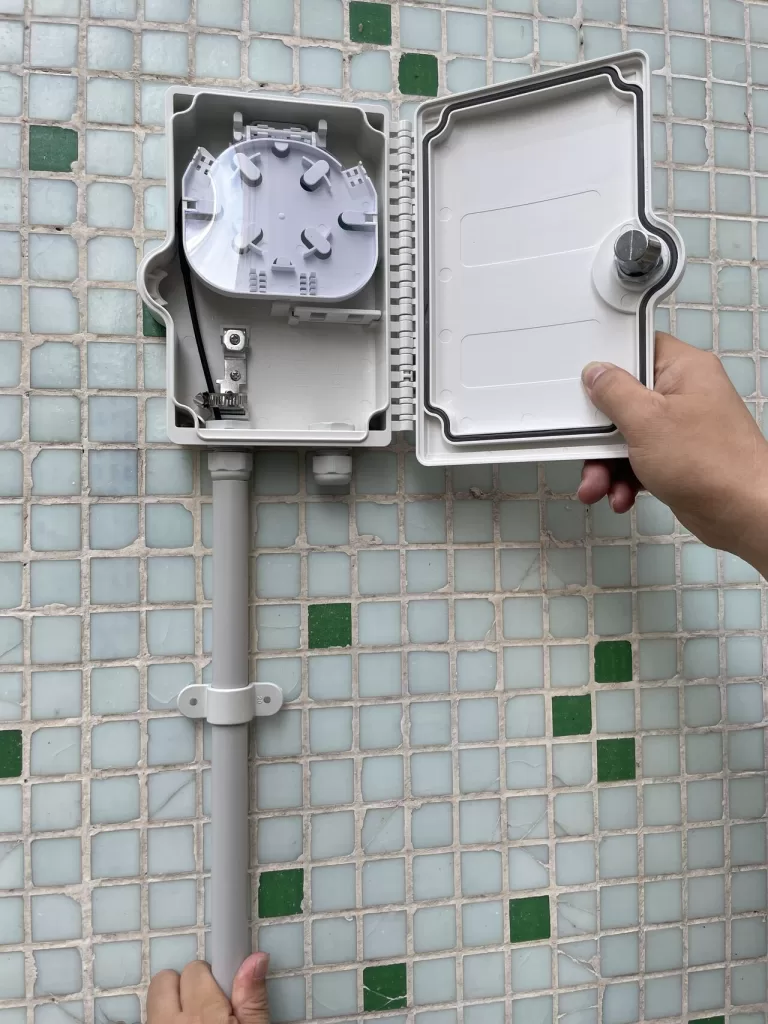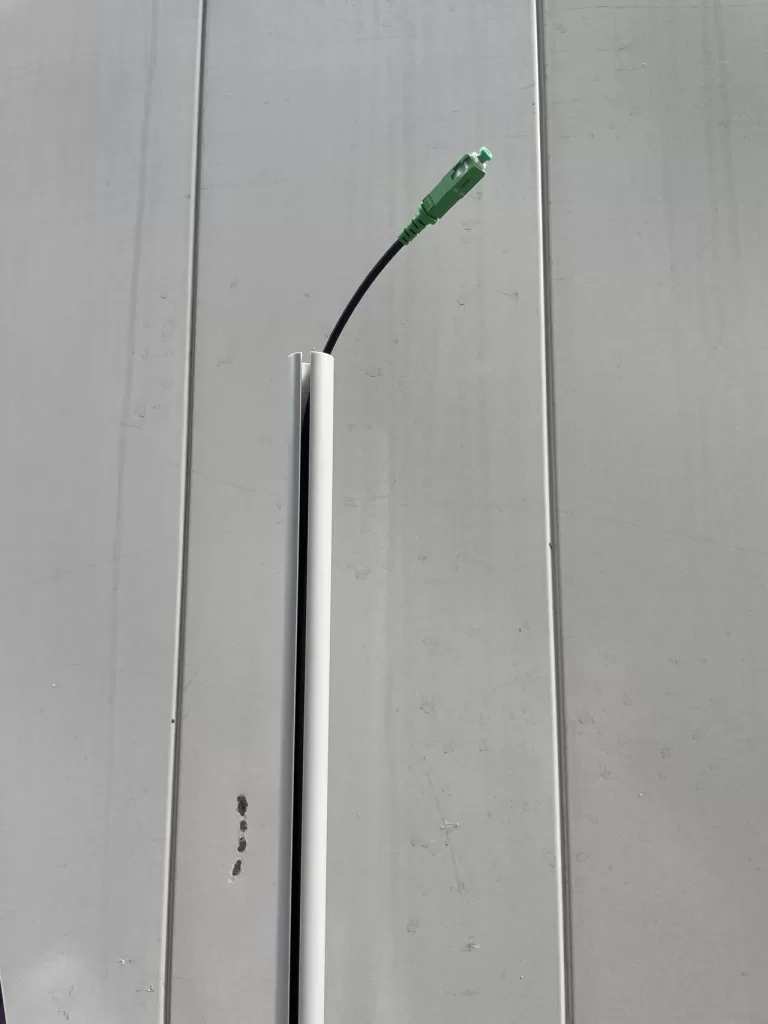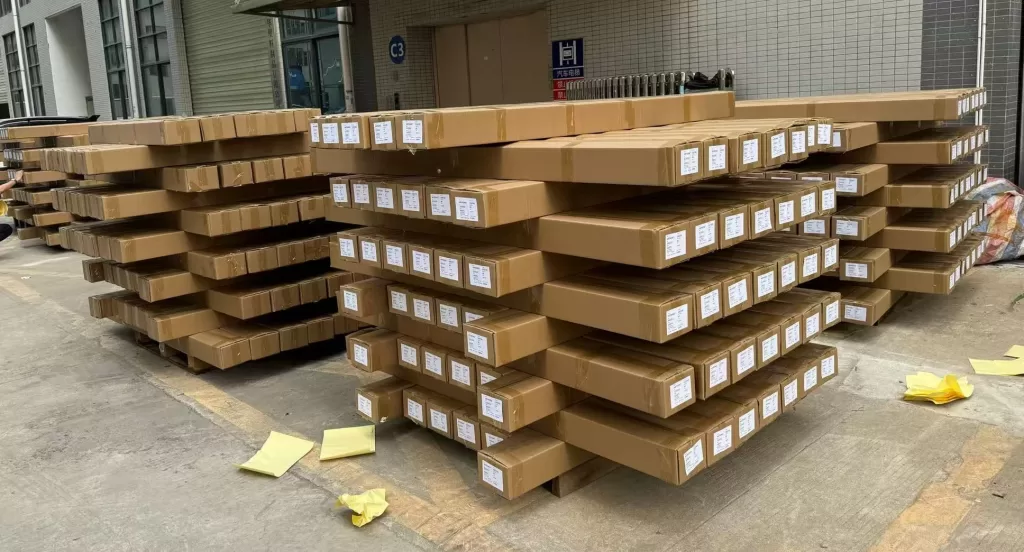In fiber optic installations—especially FTTH (Fiber to the Home)—it’s critical to protect your network from damage long after the initial cable is buried. One of the simplest, most cost-effective methods is using a PVC Split Pipe, also called Split PVC Conduit, to shield direct burial drop cables at exposed or high-risk points. This article will explain what it is, how it works, where it’s needed, and why it’s vital for long-term fiber reliability.
Table of contents
- What is a PVC Split Pipe?
- Why Use PVC Split Pipe?
- Key Benefits of Using PVC Split Pipe
- Typical Use Case: Protecting FTTH Drop Cable at Flower Bed Crossings
- Installation Guide: How to Use PVC Split Pipe
- PVC Split Pipe vs. Traditional Conduit
- Choosing the Right PVC Split Pipe
- Industry Applications of PVC Split Pipe
- Maintenance and Best Practices
- Final Thoughts
- FAQs: PVC Split Pipe for FTTH Drop Cable
What is a PVC Split Pipe?

A PVC Split Pipe is a pre-slit, rigid plastic conduit designed to be placed around existing fiber optic cable, especially direct burial FTTH drop cable. Unlike traditional conduit that must be slid over the cable before installation, split PVC conduit can be installed afterward, making it ideal for retrofits or selective reinforcement.
It’s typically made of high-impact PVC and features a longitudinal split that allows it to wrap snugly around a cable without needing to disconnect or re-terminate either end.
Key Characteristics:
- Material: High-impact polyvinyl chloride (PVC)
- Design: Longitudinal split for retrofitting
- Sizes: Common inner diameters include 20 mm, 25 mm, and 32 mm
- Länge: Typically 1 m or 2 m sections for ease of transport and selective application
- Farbe: Usually gray or white for visibility and standardization
- Anwendung: Buried over exposed drop cable to protect against external damage
Why Use PVC Split Pipe?
While direct burial FTTH drop cable is designed to withstand soil contact and moisture, it is still vulnerable to mechanical damage—especially in shallow-buried areas near:
- Flower beds
- Sidewalk crossings
- Driveway edges
- Fence lines
- Entry points near homes
In these high-risk areas, landscapers and homeowners using edgers, lawn mowers, or shovels can easily slice or nick the cable. A single cut means loss of internet or service, and repairing it is costly and time-consuming.
By adding PVC Split Pipe, you give the cable a rigid protective shell at the most vulnerable spots—without needing to pull or replace the cable.
Key Benefits of Using PVC Split Pipe
1. Post-installation Protection
Split conduit can be installed over existing cable, avoiding the need to uninstall or re-bury.
2. Mechanical Protection
It provides a tough outer shell that resists damage from:
- Lawn equipment
- Garden tools
- Accidental digging
- Rodents in some cases
3. Quick & Easy to Install
No special tools are needed. Simply open the split, insert the cable, and snap it shut.
4. Localized Use
Use only where needed (e.g., crossing flower beds or sidewalks). No need to conduit the entire cable run.
5. Cost-Effective Damage Prevention
Spending a few dollars on split PVC can save hundreds in service calls and customer downtime.
Typical Use Case: Protecting FTTH Drop Cable at Flower Bed Crossings
One of the most common failure points for direct burial fiber is when it crosses a landscaped area or flower bed. These locations are often maintained with power edgers or string trimmers—both capable of slicing through even tough outdoor-rated fiber jacket.
Installing a short section of Split PVC Conduit in these zones:
- Prevents accidental cuts
- Extends the life of the cable
- Avoids signal loss, downtime, and emergency repairs
Pro tip: Even if you buried the cable deeper elsewhere, these exposed transition points are worth reinforcing with conduit.
Installation Guide: How to Use PVC Split Pipe

Step-by-Step:
- Locate the cable where it crosses high-risk areas.
- Clear soil or mulch around the cable (if already buried shallowly).
- Open the PVC Split Pipe along its longitudinal split.
- Insert the drop cable into the pipe channel.
- Snap the pipe closed. Some models feature locking lips or tape grooves.
- Re-bury the covered section with soil or mulch.
Tips:
- Ensure the pipe extends a bit beyond the exposed area for full protection.
- Avoid overly bending the conduit; keep within standard bend radius.
- For extra protection, seal the ends with duct tape or PVC end caps.
PVC Split Pipe vs. Traditional Conduit
| Besonderheit | PVC Split Pipe | Traditional Conduit |
|---|---|---|
| Installationszeit | Fast, retrofit-friendly | Requires cable re-threading |
| Flexibilität | Moderate | High (for flexible conduits) |
| Cost | Niedrig | Moderate to High |
| Protection Level | High (for exposed sections) | Very High (full coverage) |
| Ideal Use Case | Spot protection after install | Full run protection before burying |
Choosing the Right PVC Split Pipe

When selecting PVC Split Pipe for your FTTH deployment, consider the following:
1. Inner Diameter (ID)
Match the ID to the cable’s outer diameter (OD). Leave a little slack for movement and airspace.
2. Wall Thickness
Thicker walls offer more protection but are harder to bend. Choose based on mechanical risk.
3. Length per Section
Standard 1–2 meter sections make installation simple and scalable.
4. Material Certification
Look for UV-stabilized PVC or outdoor-rated plastics for durability in exposed areas.
5. Color Coding
Standard gray is acceptable, but color-coded options (e.g., orange for fiber) help future identification.
Industry Applications of PVC Split Pipe
- Fiber ISPs and contractors (especially in aerial-to-buried transitions)
- Municipal fiber networks
- Homeowners installing FTTH from ONT to the curb
- MDUs and building drops requiring low-maintenance retrofits
It’s especially useful in retrofit projects where full re-cabling is not an option.
Maintenance and Best Practices
- Inspect exposed cable annually, especially after landscaping or construction activity.
- Keep spare split conduit on service trucks for emergency reinforcement.
- Educate customers about not disturbing marked cable zones.
- Where possible, combine split pipe with buried warning tape or marker stakes.
Final Thoughts

The PVC Split Pipe—or Split PVC Conduit—may look like a simple accessory, but it plays a crucial role in protecting FTTH infrastructure from common, costly damages. Especially in residential settings, landscaper tools and edgers pose an ever-present threat to shallow-buried fiber. With quick installation, retrofit flexibility, and affordable pricing, this small investment prevents big problems.
If you’re deploying FTTH in residential areas or maintaining an Außenanlage network, be proactive: use PVC Split Pipe at every crossing, flower bed, or transition point.
FAQs: PVC Split Pipe for FTTH Drop Cable
1. What is PVC Split Pipe used for?
It’s used to protect direct burial fiber optic cables from mechanical damage in shallow-buried or exposed areas.
2. Can I install it over existing cable?
Yes. Its split design allows for retrofitting over cables already in place—no need to disconnect.
3. Is it only for fiber optic cables?
While primarily used for FTTH drop cables, it can protect any small-diameter utility line such as irrigation wires.
4. How deep should I bury the pipe?
Typically 6–12 inches is sufficient, depending on landscaping practices and regional standards.
5. Can it be used indoors?
PVC Split Pipe is designed for outdoor use, but may also serve in wall pass-throughs or crawlspaces.
6. What’s the difference between split pipe and regular conduit?
Split pipe is designed for post-installation use—you wrap it around an existing cable. Regular conduit is used before cable install.
7. How long does PVC Split Pipe last underground?
Outdoor-rated PVC can last 20–30 years underground depending on soil and moisture conditions.
8. Where can I buy PVC Split Pipe?
We’re PVC Split Pipe manufacturer, please feel free to kontaktiere uns for free quote and free samples.
